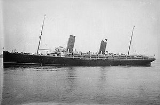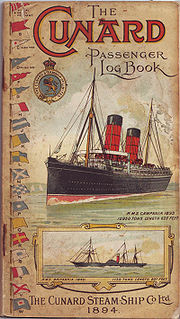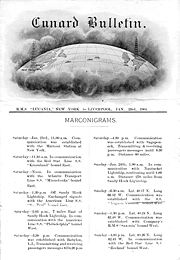
RMS Lucania
Encyclopedia
RMS
Lucania was a British
ocean liner
owned by the Cunard Steamship Line Shipping Company
, built by Fairfield Shipbuilding and Engineering Company
of Govan
, Scotland
, and launched on Thursday, 2 February 1893.
Identical in dimensions and specifications to her sister ship , RMS Lucania was the joint largest passenger liner afloat when she entered service in 1893. On her second voyage, she won the prestigious Blue Riband
from her sister to become the fastest passenger liner afloat, a title she kept until 1898.
 and Lucania were partly financed by the British Admiralty
and Lucania were partly financed by the British Admiralty
. An agreement was reached was that the Cunard
would receive funding from the Government in return for constructing vessels to admiralty specifications. Also, Cunard would have to agree to the condition that the vessels go on the naval reserve list to serve as armed merchant cruisers when required by the government. The construction contracts were awarded to the Fairfield Shipbuilding and Engineering Company
, which at the time was one of Britain’s biggest producers of warships. Plans were soon drawn up for a large, twin-screw steamer powered by triple expansion engines
, and construction began in 1891, just 43 days after Cunards'
order.
The sisters had the largest triple expansion engines
ever fitted to a Cunard ship. These engines were also the largest in the world at the time, and still rank today amongst the largest of the type ever constructed. They represent the limits of development for this kind of technology, which was superseded a few years later by turbine technology. In height, the engines reached from the double-bottom floor of the engine room to the top of the superstructure - almost three stories. Each engine had five cylinders. There were two low pressure cylinders on each engine, each measuring 8´2" (2.48 m) in diameter, and they operated with a stoke of 5' 9" (1.75 m). Together, the engines could generate 31000 IHP, which produced an average speed of 22 knots (43.1 km/h), and a record speed of 23½ knots. Normal operating speed for the engines was about 79 rpm. (Note: a modern automobile engine idles at approximately 10 times that speed)
The two engines were each placed in a separate watertight engine compartment; in case of a hull breach in that area, only one engine room would then be flooded, and the ship would still have power to return to port with the adjacent engine. In addition to this Lucania had 16 transverse watertight compartments, which meant that she could remain afloat with any two compartments flooded.
 In their day, Lucania and her sister offered the most luxurious first-class passenger accommodations available. It was Victorian
In their day, Lucania and her sister offered the most luxurious first-class passenger accommodations available. It was Victorian
opulence at its peak—an expression of a highly confident and prosperous age that would never be quite repeated on any other ship. All the first-class public rooms, and the en-suite staterooms of the upper deck, were generally heavily panelled, in oak, satinwood or mahogany; and thickly carpeted. Velvet curtains hung aside the windows and portholes, while the furniture was richly upholstered in matching design. The predominant style was Art Nouveau, although other styles were also in use, such as "French Renaissance" which was applied to the forward first-class entrance hall, whilst the 1st class smoking room was in "Elizabethan style", comprising heavy oak panels surrounding the first open fireplace ever to be used aboard a passenger liner.
Perhaps the finest room in the vessels was the first class dining saloon, over 10' (3.05 m) high and measuring 98' (30 m) long by 63' (19.2 m) wide. Over the central part of this room was a well that rose through three decks to a skylight. It was done in a style described as "modified Italian style", with the a coffered ceiling in white and gold, supported by ionic pillars. The panelled walls were done in Spanish mahogany, inlaid with ivory and richly carved with pilasters and decorations.
Maritime historian Basil Greenhill
, in his book Merchant Steamships felt that the interiors of Lucania and Campania represented the ultimate expression of the Victorian age, and remarked that later vessels' interiors degenerated into "grandiose vulgarity, the classical syntax debased to mere jargon".
 In 1901 Lucania became the first Cunard liner to be fitted with a Marconi
In 1901 Lucania became the first Cunard liner to be fitted with a Marconi
wireless system, followed a few months later by Campania. Shortly after these installations, the two ships made history by exchanging the first wireless transmitted ice bulletin; and two years after that, Lucania made history again, this time by publishing an on-board newspaper based on information received by wireless telegraphy whilst at sea. The newspaper was called Cunard Daily Bulletin and quickly became a success.
in Liverpool
. Then, at around 7.00pm on August 14th, 1909, she was badly damaged by a fire, and partially sank at her berth. Five days later she was sold for scrap, and the contents of her interior auctioned.
Royal Mail Ship
Royal Mail Ship , usually seen in its abbreviated form RMS, a designation which dates back to 1840, is the ship prefix used for seagoing vessels that carry mail under contract by Royal Mail...
Lucania was a British
United Kingdom
The United Kingdom of Great Britain and Northern IrelandIn the United Kingdom and Dependencies, other languages have been officially recognised as legitimate autochthonous languages under the European Charter for Regional or Minority Languages...
ocean liner
Ocean liner
An ocean liner is a ship designed to transport people from one seaport to another along regular long-distance maritime routes according to a schedule. Liners may also carry cargo or mail, and may sometimes be used for other purposes .Cargo vessels running to a schedule are sometimes referred to as...
owned by the Cunard Steamship Line Shipping Company
Cunard Line
Cunard Line is a British-American owned shipping company based at Carnival House in Southampton, England and operated by Carnival UK. It has been a leading operator of passenger ships on the North Atlantic for over a century...
, built by Fairfield Shipbuilding and Engineering Company
Fairfield Shipbuilding and Engineering Company
The Fairfield Shipbuilding and Engineering Company, Limited was a British shipbuilding company in the Govan area on the Clyde in Glasgow. Fairfields, as it is often known, was a major warship builder, turning out many vessels for the Royal Navy and other navies through the First World War and the...
of Govan
Govan
Govan is a district and former burgh now part of southwest City of Glasgow, Scotland. It is situated west of Glasgow city centre, on the south bank of the River Clyde, opposite the mouth of the River Kelvin and the district of Partick....
, Scotland
Scotland
Scotland is a country that is part of the United Kingdom. Occupying the northern third of the island of Great Britain, it shares a border with England to the south and is bounded by the North Sea to the east, the Atlantic Ocean to the north and west, and the North Channel and Irish Sea to the...
, and launched on Thursday, 2 February 1893.
Identical in dimensions and specifications to her sister ship , RMS Lucania was the joint largest passenger liner afloat when she entered service in 1893. On her second voyage, she won the prestigious Blue Riband
Blue Riband
The Blue Riband is an unofficial accolade given to the passenger liner crossing the Atlantic Ocean in regular service with the record highest speed. The term was borrowed from horse racing and was not widely used until after 1910. Under the unwritten rules, the record is based on average speed...
from her sister to become the fastest passenger liner afloat, a title she kept until 1898.
Power plant and construction

Admiralty
The Admiralty was formerly the authority in the Kingdom of England, and later in the United Kingdom, responsible for the command of the Royal Navy...
. An agreement was reached was that the Cunard
Cunard Line
Cunard Line is a British-American owned shipping company based at Carnival House in Southampton, England and operated by Carnival UK. It has been a leading operator of passenger ships on the North Atlantic for over a century...
would receive funding from the Government in return for constructing vessels to admiralty specifications. Also, Cunard would have to agree to the condition that the vessels go on the naval reserve list to serve as armed merchant cruisers when required by the government. The construction contracts were awarded to the Fairfield Shipbuilding and Engineering Company
Fairfield Shipbuilding and Engineering Company
The Fairfield Shipbuilding and Engineering Company, Limited was a British shipbuilding company in the Govan area on the Clyde in Glasgow. Fairfields, as it is often known, was a major warship builder, turning out many vessels for the Royal Navy and other navies through the First World War and the...
, which at the time was one of Britain’s biggest producers of warships. Plans were soon drawn up for a large, twin-screw steamer powered by triple expansion engines
Steam engine
A steam engine is a heat engine that performs mechanical work using steam as its working fluid.Steam engines are external combustion engines, where the working fluid is separate from the combustion products. Non-combustion heat sources such as solar power, nuclear power or geothermal energy may be...
, and construction began in 1891, just 43 days after Cunards'
Cunard Line
Cunard Line is a British-American owned shipping company based at Carnival House in Southampton, England and operated by Carnival UK. It has been a leading operator of passenger ships on the North Atlantic for over a century...
order.
The sisters had the largest triple expansion engines
Steam engine
A steam engine is a heat engine that performs mechanical work using steam as its working fluid.Steam engines are external combustion engines, where the working fluid is separate from the combustion products. Non-combustion heat sources such as solar power, nuclear power or geothermal energy may be...
ever fitted to a Cunard ship. These engines were also the largest in the world at the time, and still rank today amongst the largest of the type ever constructed. They represent the limits of development for this kind of technology, which was superseded a few years later by turbine technology. In height, the engines reached from the double-bottom floor of the engine room to the top of the superstructure - almost three stories. Each engine had five cylinders. There were two low pressure cylinders on each engine, each measuring 8´2" (2.48 m) in diameter, and they operated with a stoke of 5' 9" (1.75 m). Together, the engines could generate 31000 IHP, which produced an average speed of 22 knots (43.1 km/h), and a record speed of 23½ knots. Normal operating speed for the engines was about 79 rpm. (Note: a modern automobile engine idles at approximately 10 times that speed)
The two engines were each placed in a separate watertight engine compartment; in case of a hull breach in that area, only one engine room would then be flooded, and the ship would still have power to return to port with the adjacent engine. In addition to this Lucania had 16 transverse watertight compartments, which meant that she could remain afloat with any two compartments flooded.
Passenger accommodations

Victorian era
The Victorian era of British history was the period of Queen Victoria's reign from 20 June 1837 until her death on 22 January 1901. It was a long period of peace, prosperity, refined sensibilities and national self-confidence...
opulence at its peak—an expression of a highly confident and prosperous age that would never be quite repeated on any other ship. All the first-class public rooms, and the en-suite staterooms of the upper deck, were generally heavily panelled, in oak, satinwood or mahogany; and thickly carpeted. Velvet curtains hung aside the windows and portholes, while the furniture was richly upholstered in matching design. The predominant style was Art Nouveau, although other styles were also in use, such as "French Renaissance" which was applied to the forward first-class entrance hall, whilst the 1st class smoking room was in "Elizabethan style", comprising heavy oak panels surrounding the first open fireplace ever to be used aboard a passenger liner.
Perhaps the finest room in the vessels was the first class dining saloon, over 10' (3.05 m) high and measuring 98' (30 m) long by 63' (19.2 m) wide. Over the central part of this room was a well that rose through three decks to a skylight. It was done in a style described as "modified Italian style", with the a coffered ceiling in white and gold, supported by ionic pillars. The panelled walls were done in Spanish mahogany, inlaid with ivory and richly carved with pilasters and decorations.
Maritime historian Basil Greenhill
Basil Greenhill
Dr. Basil Jack Greenhill , was a diplomat, museum director and historian.He went to Bristol Grammar School, before reading philosophy, politics and economics at Bristol University, but his time there was interrupted by wartime naval service...
, in his book Merchant Steamships felt that the interiors of Lucania and Campania represented the ultimate expression of the Victorian age, and remarked that later vessels' interiors degenerated into "grandiose vulgarity, the classical syntax debased to mere jargon".
Wireless history

Guglielmo Marconi
Guglielmo Marconi was an Italian inventor, known as the father of long distance radio transmission and for his development of Marconi's law and a radio telegraph system. Marconi is often credited as the inventor of radio, and indeed he shared the 1909 Nobel Prize in Physics with Karl Ferdinand...
wireless system, followed a few months later by Campania. Shortly after these installations, the two ships made history by exchanging the first wireless transmitted ice bulletin; and two years after that, Lucania made history again, this time by publishing an on-board newspaper based on information received by wireless telegraphy whilst at sea. The newspaper was called Cunard Daily Bulletin and quickly became a success.
Final days
Lucania and Campania served as Cunard's major passenger liners for 14 years, during which time both liners were superseded in speed and size by a succession of four-funnelled German liners, starting with the in 1897. The German competition necessitated the construction of replacements for the two Cunarders, which came to fruition in 1907 with the appearance of the and . It was soon decided that Lucania was no longer needed, and her last voyage was on July 7th 1909, after which she was laid up at the Huskisson DockHuskisson Dock
Huskisson Dock is a dock on the River Mersey, England which forms part of the Port of Liverpool. It is situated in the northern dock system in Kirkdale. Huskisson Dock consists of a main basin nearest the river wall and two branch docks to the east...
in Liverpool
Liverpool
Liverpool is a city and metropolitan borough of Merseyside, England, along the eastern side of the Mersey Estuary. It was founded as a borough in 1207 and was granted city status in 1880...
. Then, at around 7.00pm on August 14th, 1909, she was badly damaged by a fire, and partially sank at her berth. Five days later she was sold for scrap, and the contents of her interior auctioned.

